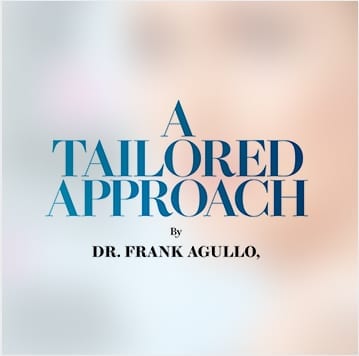Hair Transplantation Procedure
Follicular Unit Transplantation (FUT) is a surgical hair transplantation procedure which involves extracting hair from the donor area (usually the back and sides of the scalp where hair growth is permanent) and implanting to the recipient area (affected by baldness).
The procedure involves ‘follicular units’ which are basically groups of 1-4 hairs, also known as ‘grafts’. Once the patient is mildly sedated and locally anesthetized, Dr. Agullo surgically removes a strip of tissue from the donor area. His hair transplant team then surgically dissects the tissue strip into the required number of grafts or follicular units. Dr. Agullo then creates tiny incisions in the balding area in which these individual hairs will be implanted, one by one.
An Improvement over Traditional Transplant Procedures
FUT is an improvement on earlier hair transplant procedures which involved using bigger grafts and usually resulted in an unnatural look. In contrast to these traditional procedures, a single FUT session can involve transplanting thousands of follicular unit grafts, ultimately resulting in a fine aesthetic look, which ultimately is the underlying objective of the hair transplant.
Where and how the follicular units are placed on the scalp is a key decision in the hair transplant and affects the quality of the final result. Dr. Agullo evaluates each patient carefully and plans the hair restoration procedure accordingly, in order to provide the Ideally, the FUT will give a completely natural look to the patient as the procedure is essentially an imitation of natural hair growth. Take a look at our photo gallery; you will be impressed with the results!
Important FUT Concepts
FUT has a several important concepts/objectives:
- Maximizing hair transplant growth
- Ensuring naturalness of hair transplant
- Simple surgical planning
- Minimize scalp trauma
- Perform large transplants
Key FUT Terms
Here are some important Follicular Unit Transplantation terms you should know:
Follicular Units
The long-standing belief that scalp hair grew as individual strands, was proved to be incorrect. They actually grow in small groups of 1, 2, 3 or 4 hairs. The groups are called “follicular units.” This discovery was instrumental in the efficiency of FUT, when it was finally applied in hair transplants.
Graft Dissection
Graft dissection is a critical Follicular Unit Transplant aspect. The dissection is stereo-microscopic and enables the separation of follicular units without damaging them. This is important for ensuring maximum hair growth after the transplant.
Recipient Sites
Dr. Agullo makes tiny holes or slits in the patient’s scalp. These are known as the recipient sites and are the areas where the follicular unit grafts will be planted. The objective is to plant the units in these sites in a way that matches the natural hair growth. It is in the surgeon’s power how to position the grafts on the sites, ultimately affecting the orientation of the grafted hair and their growth.
Donor Area
As the name suggests, this is the area from which the follicular units are removed. It is important that the donor area, which is usually the back and sides of the scalp, is a permanent hair-bearing zone. The donor area is also important from an aesthetic point of view, as this is the area where a surgical scar is made when the surgeon makes the incision for removing the follicular units. Dr. Agullo closes the incision created using a trichophytic closure technique that maximizes healing and minimizes scarring so that the patient can comfortably keep their hair short after the transplant. This type of incision closure also allows a greater quantity of hair to be harvested in future transplants since the damage to the surrounding tissue is minimal.
Graft Numbers
Dr. Agullo makes an important decision as to how many follicular unit grafts are required to be transplanted in order to provide the best results. This number, which can range from 1400 grafts up to 6400 grafts, greatly affects the aesthetic outcome of the transplant. The grafts can be transplanted over multiple sessions or in one restoration session, as Dr. Agullo decides best and/or according to the patients’ preference.
Comparison with Follicular Unit Extraction (FUE)
In a strict sense, FUT is essentially a method of harvesting follicular units from the scalp (donor zone), which are then transplanted in the recipient sites. The other main method of harvesting these grafts is Follicular Unit Extraction, where individual follicular units are extracted from the donor area instead of removal of a strip of tissue. Comparison between the two methods is a common consideration for hair transplant patients click here to see a detailed comparison between Follicular Unit Transplantation and Follicular Unit Extraction.
Cost of Follicular Unit Extraction (FUE)
Pricing varies depending on the extent of the treatment or surgery. You can see a list of the approximate prices of each procedure on our current fee schedule. Generally speaking, cosmetic plastic surgery is considered “elective” and is not covered by most insurance plans. The prices listed on our fee schedule represent the minimum cost of the procedures, including anesthesia and surgical facility fees, medical tests, garments, and recovery products. The cost of prescription medications, however, is not included. The exact price of each procedure can only be determined after a thorough consultation. All fees must be paid in full prior to the scheduled treatment.
Visit Southwest Plastic Surgery
If you are considering a hair transplant, schedule a consultation with Dr. Agullo to discuss your hair restoration needs and any questions you might have he will be happy to answer and address your concerns.
We encourage you to make smart decisions, backed by clear understanding and our expert opinion and guidance that are always geared towards your best interests.
#HappyIsBeautiful
Schedule a risk-free evaluation with Dr. Frank Agullo today.



